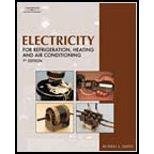Sorry! We don’t have solutions for this edition yet.
Solutions are available for other editions of this book
View 9th Edition solutionsarrow_forwardView 10th Edition solutionsarrow_forwardBook Details
Ideal for students and beginning technicians, Electricity for Refrigeration, Heating and Air Conditioning, 7E zeroes in on the basic electrical principles necessary to understand today's modern control systems. This extraordinarily practical approach allows readers to focus exclusively on the electronics information they will use in the field, without bogging them down in unnecessary theory. Chapter 9 includes new information on motor frames and electronically commutated motors, ECM. Such as the circuits being discussed in schematic diagrams, as well as the direction of the current flow within circuits. As in past editions, emphasis is on developing systematic diagnosis and troubleshooting methods and procedures in order to enable readers to become highly-skilled, professional HVAC-R service technicians. A comprehensive glossary is also included to assist those who are new to the field in understanding and using industry terms.
Features:
- learning objectives, definitions of key terms, summaries, plus plenty of review questions are included in every chapter to increase comprehension and improve retention
- new photos and illustrations encourage readers to apply information presented in the book directly to modern equipment, components, and control systems
- symbols are introduced and used consistently, and schematic diagrams of 12 specific applications used in industry are explored, enabling readers to become expert troubleshooters
- in-depth discussion of the types, designs, starting components, and diagnosis and troubleshooting procedures for single-phase motors mirrors their importance in the industry
- coverage of contactors, relays, thermostats, pressure and manual switches, overload, and other state-of-the-art electrical components prepares readers for work in the field today
- a Lab Manual includes the following for each chapter: unit overview; list of key terms; review test; and lab exercises when appropriate
- an Instructor's Guide included on the e.resource will consist of the following: short description of the material covered in each chapter; unit objectives; safety notes; lab notes; answers to Review Questions in the text; answers to Troubleshooting Problems in the text; answers to review questions in the Lab Manual; and lab exercises where applicable
More Editions of This Book
Corresponding editions of this textbook are also available below:
